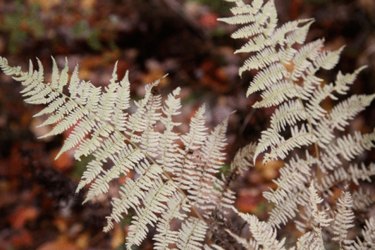Things You'll Need
Gloves
Dust mask
Pruners
Garden shears
Sharpening stone

You only have to visit the Pacific Northwest to find out that it is the perfect climate for ferns. The Olympic rain forest abounds with ferns of many types, but the sword fern is probably the most prolific. Even home gardeners landscape with ferns because they add elegant greenery and timeless ease of care. There are a great variety of ferns, most of which are perennials. Some ferns are deciduous and some are evergreen. Each type has different pruning times, but the reason for pruning is the same for each: Pruning ferns is done to increase the health of the plant and showcase the healthy fronds to best advantage.
Step 1
Wear gloves and a dust mask when pruning ferns. The gloves will protect you from the fine, often prickly hairs that many ferns have. The dust mask will keep you from inhaling the powdery spores that the fronds bear on the underside of the leaves.
Video of the Day
Step 2
Prune out the dead fronds in any fern at any time. This will keep the plant looking its best and does not harm it. The fern fronds can be chopped up and spread as mulch around the fern.
Step 3
Cut off any dead and decaying fronds on sword ferns and most Dryopteris in the fall. It is not necessary to prune all the fronds since this is mostly for cosmetic reasons. You can wait until spring and then remove any fronds that sustained damage in the winter. The plant will grow new fiddleheads in April, so this is an ideal time to clean up the fern before new growth emerges fully.
Step 4
Manicure your ferns only if you don't want them bigger. In the 1995 "Journal of the American Fern Society," a study was cited that reveals that ferns grow bigger if you leave the old leaves on them. This is a good idea if the plant is young and still small. The old fronds add energy and nourishment to the budding fiddleheads.
Step 5
Make your own decision about pruning times. There is a lot of debate about the practice, but it doesn't harm the ferns and is primarily the gardener's choice as a beautifying practice. Evergreen ferns can stay as they are and deciduous ferns such as Dryopteris are considered self-cleaning, which means the fronds fall off and disintegrate when they are spent.
Video of the Day